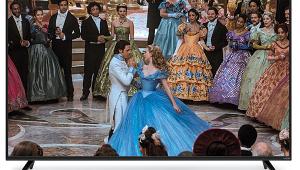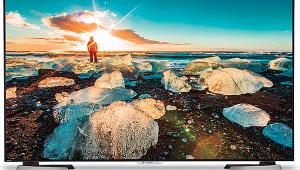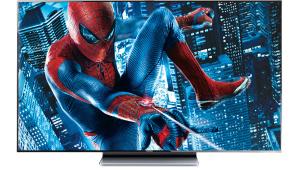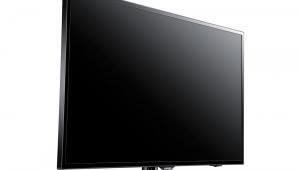Cutting Loose: Connected TV for Everybody Page 4
Insignia Connected TV
Consumer electronics retail giant Best Buy entered the burgeoning connected TV market this year with a pair of low-cost smart sets (32" and 42" screen sizes) under the Insignia brand name. Smallish, by comparison with the behemoths that are on the market nowadays, but the Insignia sets are clearly aimed at newcomers to the connected TV experience, or those looking for a secondary set, perhaps to outfit an extra room with some streaming entertainment.
Best Buy's taken a solid, if not fantastic-looking LED edge-backlit LCD and packed in a smart assortment of entry-level features, along with a reasonably good amount of content options. Around back you'll find a complete set of connections: a quartet of HDMI inputs (with ARC on the first if you're going to be using this with an AVR); RF coax, component, and composite video inputs. There are even PC connectors (DVI and VGA) if you feel like using the Insignia as a computer monitor. You connect to your network via Ethernet or onboard Wi-fi. A USB port is for service use only; there's no support for media on external drives.
You'll also find a full selection of audio connections, including optical (for Dolby Digital and stereo digital connections), analog stereo, and headphone jacks (there's also a slot for a Rocketboost wireless audio transmitter). Audyssey supplies dynamics processing, while SRS's TruSurround takes care of synthetic "surround" if you're not going to be adding a Rocketboost wireless system, a soundbar, or incorporating this into a home theater.
The included backlit universal remote (which can communicate with the set via Z-Wave RF or IR) can be configured to control three external devices in addition to the set. Oddly enough for a connected set in the Blu-ray era, the buttons are labeled "DVD", "STB", and "Aux", though perhaps that's meant to keep older users on familiar ground. Setup with most common additional boxes is quite simple, just enter the brand name and model number of your DVR/Blu-ray player/etcetera; an onboard database does the rest, so there are no codes to enter.
The Insignia set provides a basic set of content apps, including Netflix, Best Buy's own CinemaNow collection of on-demand movie and TV content, the Flingo-powered Insignia on Demand service (more off-the-beaten-path TV content), a YouTube app, and Pandora, plus a selection of news, social, and weather apps built on the Chumby platform (you can add new Chumby apps, but the process has to be done via a Web-based account; you can't do it directly from the TV itself). That's it for now - no Amazon, no Vudu, no Hulu Plus. CinemaNow does offer a library of TV content for purchase, but TV content's a bit thinner than it should be considering the competition these days.
The user interface comes courtesy of TiVo, and the look and feel will be familiar to anyone who's experienced that company's DVR interfaces, though oddly enough there's no DVR functionality here (despite the presence of a big "DVR" button on the remote). Continuing the remote's somewhat strange nomenclature, you get to the main GUI by pressing the "TiVo" button. ("Menu" might have made more sense, but you need to put the branding someplace. Take comfort in the fact that the "TV" button does jump to the live TV feed.) The TiVo interface is friendly and easy to navigate, so aside from the obvious omission, users should feel at ease. A scrollbar of films and TV suggestions floats up top, with the current selection featured at upper right. The suggestions are - as you might expect - primarily drawn from CinemaNow, with an accent on recent mainstream releases.
I got hold of a 42" model, which I duly installed in a previously TV-less (yes, it's true) bedroom. Without cable in that space, I hooked it up to an over-the-air HD antenna. Setup was very simple. I ignored the quick start guide completely while getting the TV up and running, without ill effects (the manual is pretty clear on the basics). Onscreen wizards walk you through the configuration process, from establishing a wireless connection to setting up your subscription services. Not enough? Best Buy has posted a series of handy video tutorials covering everything from turning the TV on to interfacing with Rocketboost's wireless audio components (I plugged in a Rocketfish card, followed the onscreen menus and had a wireless satellite up and running in a matter of minutes), should you need more of a helping hand than the print materials can provide.
In use, the Insignia performed much as expected - it's a capable performer on several fronts, and without big surprises for the most part, but there's a frustrating mix of simplicity and back-end complexity here that makes the overall experience less friendly than it could be.
The Insignia remote seems a bit complex and overspec'd for the task at hand (I'm not sure, given the small number of provided apps, that I needed buttons for both the GUI's homescreen and the apps menu). The remote is highly configurable, however, with most of the buttons reprogrammable with alternative commands or macros - interesting, but it seems somewhat out of place given the set's basic connected functionality.
I had some other quibbles - While for an inexpensive set the Insignia doesn't look bad (the various viewing modes seem reasonably well-matched to typical real-world conditions), picture adjustments are buried in submenus beneath the viewing modes (and some are inaccessible without service codes), making them difficult to find and fine tune. This is especially frustrating given how accessible and complete the audio adjustments are. I did manage to get things set up more-or-less to my liking (I didn't do a formal calibration), but even so backlighting was less uniform than I'd like to see, with visible glare in the corners of the screen that was quite noticeable on dark scenes, something beyond the reach of user adjustments in any case.
The Netflix app seemed somewhat unstable, more so than other implementations I've seen recently; it took several attempts at authorizing my account to begin with, and I periodically encountered notices that the service was unavailable. Cycling the set off and on again generally got me around this issue (which Best Buy's reps told me they hadn't encountered). I didn't much care for the viewing suggestions the Insignia made for me, but perhaps that's just a matter of taste; there's also the slightly intrusive sense that you're being upsold, which I can imagine might alienate the older folks who might be the target market for this set.
In the end, the Insignia may not be so much a cable-cutting device as it is a gateway to online content for those basically happy with their cable experience. The full-featured remote really cries out for a partnership with a full-featured DMR, cable box, or cable-ready DVR (like one of TiVo's units), an arrangement that'd make plenty of sense.
- Log in or register to post comments























































